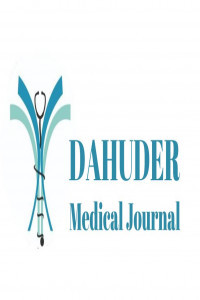Evaluation of Interleukin 6 Levels in Severe COVID-19 Patients
Evaluation of Interleukin 6 Levels in Severe COVID-19 Patients
COVID-19, Interleukin 6, Cytokine Storm, Macrophage Activation Syndrome,
___
- Zhang J, Hao Y, Ou W, Ming F, Liang G, Qian Y et al. Serum interleukin-6 is an indicator for severity in 901 patients with SARS-CoV-2 infection: a cohort study. J Transl Med. 2020;18(1).
- Chen T, Wu D, Chen H, Yan W, Yang D, Chen G et al. Clinical characteristics of 113 deceased patients with coronavirus disease 2019: retrospective study. BMJ. 2020;m1091.
- Galván-Román J, Rodríguez-García S, Roy-Vallejo E, Marcos-Jiménez A, Sánchez-Alonso S, Fernández-Díaz C. IL-6 serum levels predict severity and response to tocilizumab in COVID-19: An observational study. J Allergy Clinic Immunol. 2021;147(1):72-80.e8.
- Narazaki M, Kishimoto T. The Two-Faced Cytokine IL-6 in Host Defense and Diseases. Int J Mol Sci. 2018;19(11):3528.
- Swaroopa D, Bhaskar K, Mahathi T, Katkam S, Raju Y, Chandra N et al. Association of serum interleukin-6, interleukin-8, and Acute Physiology and Chronic Health Evaluation II score with clinical outcome in patients with acute respiratory distress syndrome. Indian J Crit Care Med. 2016;20(9):518-525.
- Herold T, Jurinovic V, Arnreich C, Hellmuth J, von Bergwelt-Baildon M. Level of IL-6 predicts respiratory failure in hospitalized symptomatic COVID-19 patients. 2020;146(1):128-136
- Chen W, Lan Y, Yuan X, Deng X, Li Y, Cai X. Detectable 2019-nCoV viral RNA in blood is a strong indicator for the further clinical severity. Emerg Microbes Infect. 2020;9(1):469-473.
- Antisitokin-Antiinflamatuar Tedaviler, Koagülopati Yönetimi . Covid19.saglik.gov.tr. 2022. https://covid19.saglik.gov.tr/TR-66341/antisitokin-antiinflamatuar-tedaviler-koagulopati-yonetimi.html (accessed February 2022)
- Scheller J, Chalaris A, Schmidt-Arras D, Rose-John S. The pro- and anti-inflammatory properties of the cytokine interleukin-6. Biochim Biophys Acta. 2011;1813(5):878-888.
- Barek M, Aziz M, Islam M. Impact of age, sex, comorbidities and clinical symptoms on the severity of COVID-19 cases: A meta-analysis with 55 studies and 10014 cases. Heliyon. 2020;6(12):e05684.
- Cagnacci A, Xholli A. Age-related difference in the rate of coronavirus disease 2019 mortality in women versus men. Am J Obstet Gynecol. 2020;223(3):453-454.
- Li X, Xu S, Yu M, Wang K, Tao Y, Zhou Y. Risk factors for severity and mortality in adult COVID-19 inpatients in Wuhan. J Allergy Clin Immunol. 2020;146(1):110-118.
- Yayın Aralığı: Yılda 4 Sayı
- Başlangıç: 2021
- Yayıncı: DAHUDER
İhsan SOLMAZ, Ömer Faruk ALAKUŞ, Yusuf YAKUT, Yunus TEKİN, Sedrettin KOYUN, Eşref ARAÇ
Right time for the community based mental health care
Approach To Diagnosis And Treatment Of Familial Hyperlipidemia
Kübra ÇERÇİ, İmge Bortay TEKİN, Seyit UYAR
Zeynep YÜKSEL, Ahmet Zafer CALISKANER
Evaluation of Interleukin 6 Levels in Severe COVID-19 Patients
Yıldız OKUTURLAR, İftihar KÖKSAL, Yasemin GÜNDOĞDU, Arzu YÜKSEL, Özgür OKUTURLAR, Fadıl HAVAS, Cem GUN
